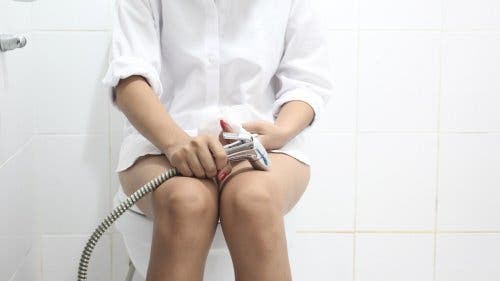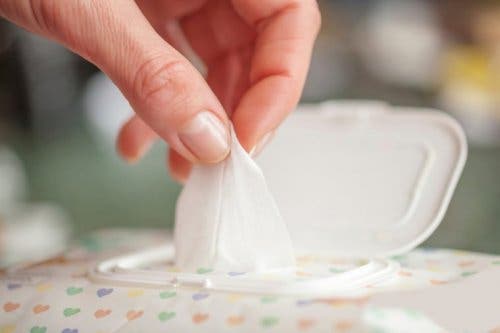Before and After Oral Sex Hygiene Tips

Before and after oral sex, hygiene is very important. However, people don’t usually pay enough attention to it. In this article, you won’t only some oral sex hygiene tips, but, also, the consequences of not doing it.
When it comes to oral sex, people tend to ignore different precautions that they would consider in vaginal or anal sex. An example is not using a condom or oral barriers.
Before and after oral sex hygiene tips
As the article Level of knowledge and risk behaviors related to sexually transmitted infections among female adolescents points out, the risk of catching an STD through oral sex is high. For this reason, it’s also necessary to address the issue of hygiene.
Although you may think that hygiene before and after oral sex is the same, it’s necessary to become aware of the importance of doing it in the most appropriate way for your health. For this, we’ll delve deeper into different parts that you must pay greater attention to.
Before hygiene

We’ll start with the hygiene that you need to carry out before oral sex. Wash the area very well with soap or, better yet, a suitable soap for the intimate area. Men shouldn’t forget about the testicles and perineum, and women should focus on the labia majora and labia minora.
Men who aren’t circumcised often accumulate smegma, as the article Male circumcision for reducing risk of infection with human immunodeficiency virus and sexually transmitted infections points out. This is a white discharge that can produce unpleasant odors.
The way to avoid this is to pull back the foreskin and apply plenty of water to the head of the penis. After this, you must dry your intimate area very well to prevent moisture from allowing fungal growth.
In the case of women, also after cleaning the genital area well, including the anus, they should dry this area well. It’s a way to avoid problems, such as vaginal candidiasis.
This article may interest you: Seven Myths About Oral Sex and its Health Consequences Busted
Hygiene after oral sex
After having sex, you may not want to wash your intimate area again. However, this is extremely important. In what way should you do it? Why is it so important? Discover it in the following points:
- To avoid the formation of bacteria. Cleaning the genital area prevents the growth of bacteria. Especially if you’ve used lubricants, oils, or condoms.
- Reduce the risk of cystitis. This is a problem that affects women and can be avoided by washing the intimate area after oral sex. It isn’t convenient for it to stay moist.
If you had sex outside your home and there’s no possibility of using a bidet, you can use disposable wipes. Therefore, it’s important for you to always carry them around with you.

The mouth in oral sex
You’ve seen some before and after oral sex hygiene tips. However, you must pay special attention to oral hygiene, especially before having sex. The reason is that the mouth is a great source of bacteria.
However, it’s also worth remembering the importance of preventing sexually transmitted diseases. The use of condoms and dental dams are resources that prevent this contagion.
Read on to learn more: Seven Questions about the Female Condom
People often believe that STDs don’t spread from the genitals to the mouth. But this is an unfortunate mistake. For example, human papillomavirus can lead to oral cancer. Therefore, regarding hygiene, we must also mention the importance of adequately protecting yourself.
We hope this article allowed you to better understand what you must pay attention to regarding before and after oral sex hygiene. Likewise, we encourage you to become aware of the importance of protecting yourself during this type of intimate encounter.
Sexually transmitted diseases are becoming increasingly common. If you want to enjoy oral sex without worries, don’t forget to consider the protection methods. Do you take them into account for oral sex?
All cited sources were thoroughly reviewed by our team to ensure their quality, reliability, currency, and validity. The bibliography of this article was considered reliable and of academic or scientific accuracy.
- Arab, H., Almadani, L., Tahlak, M. & Haddad, E. (2011). The Middle East and Central Asia guidelines on female genital hygiene. BMJ Middle East, 19, 99-106. Disponible en: https://www.researchgate.net/publication/305032196_the_middle_east_and_central_Asia_guidelines_on_female_genital_hygine#:~:text=Pre%20and%20post%20coital%20cleansing,to%20avoid%20sensitivity%20and%20scarring.
- Harris, L. (2013) Does urinating after intercourse reduce the risk of urinary tract infections among women? Evidence-Based Practice, 16(5), 6. Disponible en: https://journals.lww.com/ebp/Abstract/2013/05000/Does_urinating_after_intercourse_reduce_the_risk.8.aspx
- Hawkins, D.A. (2001). Oral sex and HIV transmission. Sexually Transmitted Infections, 77(5), 307-308. Disponible en: https://sti.bmj.com/content/77/5/307
- Kumar, T., Puri, G., Aravinda, K., et al. (2015). Oral sex and oral health: An enigma in itself. Indian journal of sexually transmitted diseases and AIDS, 36(2), 129–132. Disponible en: https://www.ncbi.nlm.nih.gov/pmc/articles/PMC4660550/
- Queirós, C. & Costa, J. (2019). Oral Transmission of Sexually Transmissable Infections: A Narrative Review. Acta medica portuguesa, 32(12), 776–781. Disponible en: https://pubmed.ncbi.nlm.nih.gov/31851887/
- Saini, R., Saini, S. & Sharma, S. (2010). Oral sex, oral health and orogenital infections. Journal of global infectious diseases, 2(1), 57–62. Disponible en: https://www.ncbi.nlm.nih.gov/pmc/articles/PMC2840968/
- Santa, R., Hueso, C., Martín, A., et al. (2020). Association between Sexual Habits and Sexually Transmitted Infections at a Specialised Centre in Granada (Spain). International journal of environmental research and public health, 17(18), 1-9. Disponible en: https://www.ncbi.nlm.nih.gov/pmc/articles/PMC7557876/
- Stock, M., Peterson, L., Houlihan, A. & Walsh, L. (2013). Influence of oral sex and oral cancer information on young adults’ oral sexual-risk cognitions and likelihood of HPV vaccination. Journal of sex research, 50(1), 95-102. Disponible en: https://www.tandfonline.com/doi/abs/10.1080/00224499.2011.642904
This text is provided for informational purposes only and does not replace consultation with a professional. If in doubt, consult your specialist.








